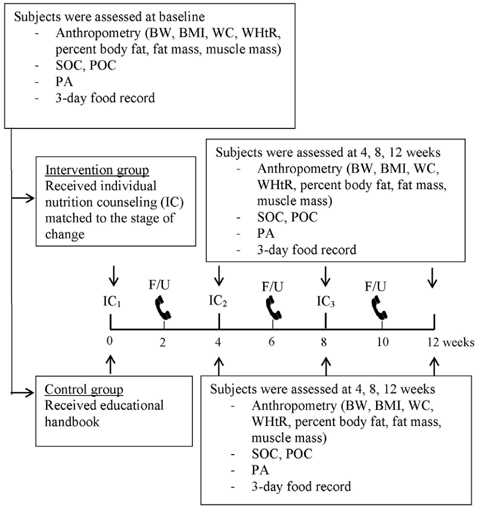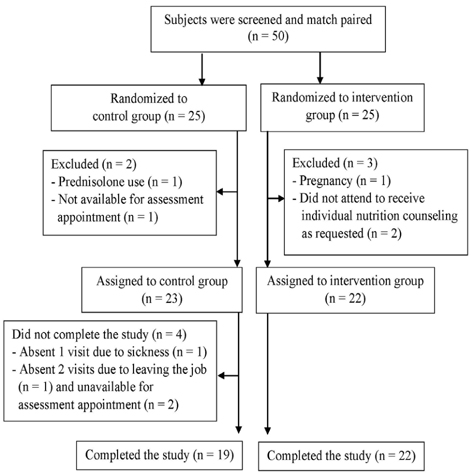Nutr Res Pract.
2017 Aug;11(4):319-326. 10.4162/nrp.2017.11.4.319.
A randomized controlled trial of an individualized nutrition counseling program matched with a transtheoretical model for overweight and obese females in Thailand
- Affiliations
-
- 1Department of Nutrition and Dietetics, Faculty of Allied Health Sciences, Chulalongkorn University, 154 Rama 1 Road, Pathumwan, Bangkok 10330, Thailand. jongjitan@yahoo.com
- KMID: 2385470
- DOI: http://doi.org/10.4162/nrp.2017.11.4.319
Abstract
- BACKGROUND
/OBJECTIVE: Effective weight reduction remains a challenge throughout the world as the prevalence of obesity and its consequences are increasing. This study aimed to determine the effects of an individualized nutrition counseling program (IC) matched with a transtheoretical model (TTM) for overweight and obese subjects.
SUBJECTS/METHODS
Fifty overweight and obese subjects aged 19-60 years with a body mass index ≥ 23 kg/m² were enrolled in the weight reduction study. They were randomized into two groups: Intervention group received an IC matched with a TTM; control group received an educational handbook. Body weight (BW), body fat (BF), waist circumference (WC), waist to height ratio (WHtR), stages of change (SOC), processes of change (POC), food intake, and physical activity (PA) were assessed at baseline and at 4, 8, and 12 weeks after program initiation in both groups. All data were analyzed by intention-to-treat, using SPSS software for hypothesis testing.
RESULTS
Forty-five female subjects were included in the 12-week trial at Ramkhamhaeng Hospital, Bangkok, Thailand. The results showed significant weight loss (1.98 ± 1.75 kg; 3% loss of initial weight) in the intervention group at 12 weeks, compared to a 0.17 ± 1.67 kg loss in the control group. There were significant differences between intervention and control groups in BF mass (-1.68 ± 1.78, -0.04 ± 1.62 kg); percentage BF (-1.54 ± 2.11, 0.08 ± 2.05); WC (-5.35 ± 3.84, 0.13 ± 3.23 cm); WHtR (-0.0336 ± 0.02, -0.0004 ± 0.02), and energy consumption (-405.09 ± 431.31, -74.92 ± 499.54 kcal/day) in the intervention and control groups, respectively. Intragroup SOC was improved in both groups. The POC for the weight management action (WMA) process was significantly different with POC scores increasing by 16.00 ± 11.73 and 7.74 ± 14.97 in the intervention and the control groups, respectively. PA level did not change in either group.
CONCLUSIONS
The IC matched with a TTM resulted in reductions in BW, BF, and WC, thus reducing likely health risks by decreasing energy intake and inducing positive behavior changes while enhancing the WMA process.
Keyword
MeSH Terms
Figure
Cited by 1 articles
-
Importance of Adherence to Personalized Diet Intervention in Obesity Related Metabolic Improvement in Overweight and Obese Korean Adults
Juhyun An, So Ra Yoon, Jae Hyang Lee, Hyunyoung Kim, Oh Yoen Kim
Clin Nutr Res. 2019;8(3):171-183. doi: 10.7762/cnr.2019.8.3.171.
Reference
-
1. World Health Organization. Obesity and overweight: Fact sheet [Internet]. Media centre: World Health Organization;2016. cited 21 May 2017. Available from: http://www.who.int/mediacentre/factsheets/fs311/en/.2. World Health Organization Western Pacific Region. International Association for the Study of Obesity. International Obesity Task Force. The Asia-Pacific Perspective: Redefining Obesity and Its Treatment. Sydney: Health Communications Australia Pty Limited;2000.3. Snetselaar LG. Nutrition Counseling Skills for the Nutrition Care Process. 4th ed. Sudbury (MA): Jones and Bartlett Publishers;2009. p. 77–96. p. 113–140.4. National Clinical Guideline Centre (UK). Obesity: Identification, Assessment and Management of Overweight and Obesity in Children, Young People and Adults. London: National Institute for Health and Care Excellence;2014.5. Hamman RF, Wing RR, Edelstein SL, Lachin JM, Bray GA, Delahanty L, Hoskin M, Kriska AM, Mayer-Davis EJ, Pi-Sunyer X, Regensteiner J, Venditti B, Wylie-Rosett J. Effect of weight loss with lifestyle intervention on risk of diabetes. Diabetes Care. 2006; 29:2102–2107.
Article6. Look AHEAD Research Group. Jakicic JM, Blackburn G, Bloomquist P, Bray GA, Clark JM, Coday M, Curtis JM, Egan C, Evans M, Foreyt J, Foster G, Hazuda HP, Hill JO, Horton ES, Hubbard VS, Jeffery RW, Johnson KC, Kitabchi AE, Knowler WC, Kriska A, Lang W, Lewis CE, Montez MG, Nathan DM, Neiberg RH, Patricio J, Peters A, Pi-Sunyer X, Pownall H, Redmon B, Regensteiner J, Rejeski J, Ribisl PM, Safford M, Stewart K, Trence D, Wadden TA, Wing RR, Yanovski SZ. Association of the magnitude of weight loss and changes in physical fitness with long-term cardiovascular disease outcomes in overweight or obese people with type 2 diabetes: a post-hoc analysis of the Look AHEAD randomised clinical trial. Lancet Diabetes Endocrinol. 2016; 4:913–921.
Article7. Holli BB, Beto JA. Nutrition Counseling and Education Skills for Dietetics Professionals. 6th ed. Philadelphia (PA): Lippincott Williams & Wilkins;2014. p. 107–133.8. Spahn JM, Reeves RS, Keim KS, Laquatra I, Kellogg M, Jortberg B, Clark NA. State of the evidence regarding behavior change theories and strategies in nutrition counseling to facilitate health and food behavior change. J Am Diet Assoc. 2010; 110:879–891.
Article9. Prochaska JO, Velicer WF. The transtheoretical model of health behavior change. Am J Health Promot. 1997; 12:38–48.
Article10. Mastellos N, Gunn LH, Felix LM, Car J, Majeed A. Transtheoretical model stages of change for dietary and physical exercise modification in weight loss management for overweight and obese adults. Cochrane Database Syst Rev. 2014; CD008066.
Article11. Kantachuvessiri A. Obesity in Thailand. J Med Assoc Thai. 2005; 88:554–562.12. Prasertsarn M. The effects of individual counseling based on behaviourism counseling theory on self controlled weight reduction behaviors of obese adolescents at Santirajvitayalai school in Bangkok metropolis [master's thesis]. Sukhothai: Sukhothai Thammathirat Open University;2005.13. Vuttisinaksara S. The motivation approach for dietary control on blood pressure and weight reduction among overweight/obese hypertensive patients [master's thesis]. Bangkok: Mahidol University;2013.14. Khamtanot S. The application of the self-efficacy theory on food consumption behavior and physical activity among women with abdominal obesity, Samko hospital, Angthong province [master's thesis]. Bangkok: Mahidol University;2013.15. Utsahakij S. Effects of self-efficacy promotion program on weight control behaviors and body mass index among overweight middle age women [master's thesis]. Phitsanulok: Naresuan University;2007.16. Kaenphueak Y, Junprasert S, Asawachaisuwikrom W. Outcomes of self-regulation on eating behavior and brisk walk for weight control in overweight women. Public Health J Burapha Univ. 2014; 9:104–116.17. Andrés A, Saldaña C, Gómez-Benito J. Establishing the stages and processes of change for weight loss by consensus of experts. Obesity (Silver Spring). 2009; 17:1717–1723.
Article18. Jensen MD, Ryan DH, Apovian CM, Ard JD, Comuzzie AG, Donato KA, Hu FB, Hubbard VS, Jakicic JM, Kushner RF, Loria CM, Millen BE, Nonas CA, Pi-Sunyer FX, Stevens J, Stevens VJ, Wadden TA, Wolfe BM, Yanovski SZ. American College of Cardiology/American Heart Association Task Force on Practice Guidelines. Obesity Society. 2013 AHA/ACC/TOS guideline for the management of overweight and obesity in adults: a report of the American College of Cardiology/American Heart Association Task Force on Practice Guidelines and The Obesity Society. J Am Coll Cardiol. 2014; 63:2985–3023.
Article19. Andrés A, Saldaña C, Beeken RJ. Assessment of processes of change for weight management in a UK sample. Obes Facts. 2015; 8:43–53.
Article20. Andrés A, Saldaña C, Gómez-Benito J. The transtheoretical model in weight management: validation of the processes of change questionnaire. Obes Facts. 2011; 4:433–442.
Article21. Ceccarini M, Borrello M, Pietrabissa G, Manzoni GM, Castelnuovo G. Assessing motivation and readiness to change for weight management and control: an in-depth evaluation of three sets of instruments. Front Psychol. 2015; 6:511.
Article22. Rattanawiwatpong P, Khunphasee A, Pongurgsorn C, Intarakamhang P. Validity and reliability of the Thai version of short format International Physical Activity Questionnaire (IPAQ). J Thai Rehabil. 2006; 16:147–160.23. International Physical Activity Questionnaire Research Committee. Guidelines for Data Processing and Analysis of the International Physical Activity Questionnaire (IPAQ): Short and Long Forms. [place unknown]: IPAQ Group;2005.24. Johnson SS, Paiva AL, Cummins CO, Johnson JL, Dyment SJ, Wright JA, Prochaska JO, Prochaska JM, Sherman K. Transtheoretical model-based multiple behavior intervention for weight management: effectiveness on a population basis. Prev Med. 2008; 46:238–246.
Article25. Menezes MC, Mingoti SA, Cardoso CS, Mendonça RD, Lopes AC. Intervention based on Transtheoretical Model promotes anthropometric and nutritional improvements - a randomized controlled trial. Eat Behav. 2015; 17:37–44.
Article26. Ashwell M, Gibson S. Waist-to-height ratio as an indicator of ‘ early health risk’: simpler and more predictive than using a ‘ matrix’ based on BMI and waist circumference. BMJ Open. 2016; 6:e010159.27. Hsieh SD, Yoshinaga H, Muto T. Waist-to-height ratio, a simple and practical index for assessing central fat distribution and metabolic risk in Japanese men and women. Int J Obes Relat Metab Disord. 2003; 27:610–616.
Article28. Aekplakorn W, Pakpeankitwatana V, Lee CM, Woodward M, Barzi F, Yamwong S, Unkurapinun N, Sritara P. Abdominal obesity and coronary heart disease in Thai men. Obesity (Silver Spring). 2007; 15:1036–1042.
Article29. Schneider HJ, Friedrich N, Klotsche J, Pieper L, Nauck M, John U, Dörr M, Felix S, Lehnert H, Pittrow D, Silber S, Völzke H, Stalla GK, Wallaschofski H, Wittchen HU. The predictive value of different measures of obesity for incident cardiovascular events and mortality. J Clin Endocrinol Metab. 2010; 95:1777–1785.
Article30. Råberg Kjøllesdal MK, Hjellset VT, Bjørge B, Holmboe-Ottesen G, Wandel M. Intention to change dietary habits, and weight loss among Norwegian-Pakistani women participating in a culturally adapted intervention. J Immigr Minor Health. 2011; 13:1150–1158.
Article31. Soenen S, Martens EA, Hochstenbach-Waelen A, Lemmens SG, Westerterp-Plantenga MS. Normal protein intake is required for body weight loss and weight maintenance, and elevated protein intake for additional preservation of resting energy expenditure and fat free mass. J Nutr. 2013; 143:591–596.
Article32. Trumbo P, Schlicker S, Yates AA, Poos M. Food and Nutrition Board of the Institute of Medicine, The National Academies. Dietary reference intakes for energy, carbohydrate, fiber, fat, fatty acids, cholesterol, protein and amino acids. J Am Diet Assoc. 2002; 102:1621–1630.
Article33. National Statistic Office. Ministry of Information and Communication Technology (TH). The 2007 Exercise Behavior Survey. Bangkok: National Statistical Office, Ministry of Information and Communication Technology;2007.34. Kantachuvessiri A, Sirivichayakul C, KaewKungwal J, Tungtrongchitr R, Lotrakul M. Factors associated with obesity among workers in a metropolitan waterworks authority. Southeast Asian J Trop Med Public Health. 2005; 36:1057–1065.35. Aekplakorn W. National Health Examination Survey V, Thailand. Bangkok: National Health Examination Survey Office;2016.
- Full Text Links
- Actions
-
Cited
- CITED
-
- Close
- Share
- Similar articles
-
- Transtheoretical Model Based Exercise Counseling Combined with Music Skipping Rope Exercise on Childhood Obesity
- Effects of Customized Nutritional Education 'Change 10 Habits' Program According to Stage of Behavior Change in Mildly Obese Adults
- Development and Evaluation of an App-Based Self-Management Program for Exercise Practice of Breast Cancer Survivors: A Non-Randomized Controlled Trial
- The Effect of Nutrition Education Program on Overweight/Obese Patients with Non-Alcoholic Fatty Liver Disease: a Single-Blind Parallel Randomized Controlled Trial
- Wheel of Wellness Counseling in Community Dwelling, Korean Elders: A Randomized, Controlled Trial



